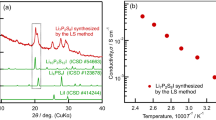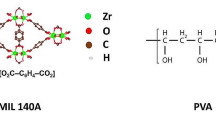Abstract
To further improve the thermal stability of capturing radioactive gaseous iodine in nuclear industrial waste gas, “Ionic liquids (ILs)” was introduced into the field of iodine adsorption. By regulating the aging temperature, aging time and molar ratio of reactants, the amine compound was prepared into ILs, and the micro structure and orthogonal test were studied to obtain the best quality response combination of ILs preparation. The physical properties, thermal stability and iodine adsorption properties of different ILs are tested. The results show that the iodine adsorption efficiency of amine compounds ILs is at the same level as that of activated carbon base composites under the same load conditions, while the thermal stability is improved by 113%, which has important theoretical guiding significance for the improvement of the adsorption properties of the iodine adsorbents under the high temperature conditions.














Similar content being viewed by others
References
Hao Z, Facheng Yi, Mianxin S et al (2019) Novel synthesis of Bi-Bi2O3-TiO2-C composite for capturing iodine-129 in off-gas. J Hazard Mater 365:81–87
The People's Republic of China (2021) The 14th Five Year Plan for National Economic and Social Development of the People's Republic of China and the Outline of the Long Range Goals for 2035 [EB/OL]
Yang JH, Cho YJ, Shin JM et al (2015) Bismuth-embedded SBA-15 mesoporous silica for radioactive iodine capture and stable storage. J Nucl Mater 465:556–564
Longqing Y (2013) Study on the adsorption and desorption properties of modified activated carbon for radioactive methyl iodine. China Academy of Engineering Physics, Mianyang
Jirong Z, Yongguo Li, Lihong H et al (2016) Discussion on impregnators for improving the iodine removal performance of activated carbon. Nucl Saf 15(1):5
Wood G (1980) Desorption of TEDA from impregnated charcoals. The 16th nuclear air cleaning and treatment conference, San Diego
Kunjun W, Sen C, Longjiang W et al (2021) Study on the properties and microstructure aging effects of impregnated activated carbon. Radiat Protect 41(04):351–358
Hou J, Shi Y, Li Y et al (2014) Research on vacuum impregnation and pre drying production process of nuclear grade activated carbon. Radiat Protect 34(03):183–192
Kovach JL, Holladay DW, Deitz VR et al (1986) Purification and monitoring of iodine in radioactive waste gas. Version 1. Li Qidong, He Suiyuan, Huang Changtai, Translation. Atomic Energy Publishing House, Beijing, pp 141–174
Longqing Y, Deliu L, Ziyu Y (2013) Hexamethylenetetramine impregnated activated carbon for capturing methyl iodine. Nucl Radiochem 35(2):121–124
Sanaei-Rad S, Saeidiroshan H, Mirhosseini-Eshkevari B et al (2021) Hexamethylenetetramine-based ionic liquid anchored onto the metal-organic framework MIL-101(Cr) as a superior and reusable heterogeneous catalyst for the preparation of hexahydroquinolines. Res Chem Intermed 47(5):2143–2159
Yongguo Li, Biao Y, Kai Y et al (2020) Research status of ionic liquid adsorption gas and feasibility study on its application in radioactive CHI3 purification. Environ Sci Manag 45(01):33–36
Zeng S, Zhang X, Bai L et al (2017) Ionic-liquid-based CO2 capture systems: structure, interaction and process. Chem Rev 117(14):9625–9673
Zhiming X, Zhichao X (2017) The high-efficiency and eco-friendly PEGylated ionic liquid systems for radioactive iodine capture through halogen bonding interaction. J Mol Liq 238:106–114
Yaqiang X, Tingting P, Qiong L et al (2022) Efficient and simultaneous capture of iodine and methyl iodide achieved by a covalent organic framework. Nat Commun 13(1):2878
American Society for Testing and Materials (1998) ASTM D 3803-1998 standard test method for nuclear-grade activated carbon. ASTM International, Philadelphia
Acknowledgements
This research was supported by the “Young Talents Project” of China National Nuclear Corporation No. JY21030603 and “Innovation Team Fund project” of China institute for radiation protection (YC21000603).
Author information
Authors and Affiliations
Corresponding author
Additional information
Publisher's Note
Springer Nature remains neutral with regard to jurisdictional claims in published maps and institutional affiliations.
Rights and permissions
Springer Nature or its licensor (e.g. a society or other partner) holds exclusive rights to this article under a publishing agreement with the author(s) or other rightsholder(s); author self-archiving of the accepted manuscript version of this article is solely governed by the terms of such publishing agreement and applicable law.
About this article
Cite this article
Li, X., Chen, Z., Chen, X. et al. Study on iodine adsorbents preparation and performance for different TEDA ionic liquids. J Radioanal Nucl Chem 332, 5023–5034 (2023). https://doi.org/10.1007/s10967-023-09139-1
Received:
Accepted:
Published:
Issue Date:
DOI: https://doi.org/10.1007/s10967-023-09139-1




